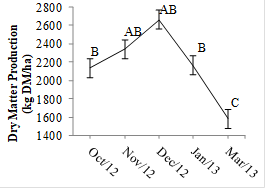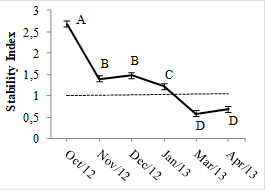ABSTRACT
The objective of this study is to verify the population density and the dynamics of tillering in the Marandu palisade grass sward subjected to nitrogen (N) fertilization strategies, characterized by the N supply via urea or bacterial inoculant (Azospirillum brasilense). The treatments comprised of four nitrogen fertilization strategies: (A) Without fertilization, (B) 80 kg N/ha, (C) inoculant (A. brasilense), and (D) 80 kg N/ha + inoculant, distributed in a randomized complete block design, with three replications. The nitrogen supply strategies were evaluated during six periods: October, November, and December (2012) as well as January, March, and April (2013). The nitrogen dose or inoculant had no effect on the tiller appearance rate (TAR), tiller mortality rate (TMR), tiller survival rate (TSR), or tiller population density (TPD). However, these variables were influenced by the season. The TAR and TSR were higher at the beginning of the experimental period (October) and lower towards the end of the period (March-April), whereas, TMR and TPD exhibited the opposite behavior, with lower values in October and higher from January onward. Neither the nitrogen nor the inoculant influenced the population dynamics of the tillers in Marandu palisade grass.
Keywords:
diazotrophic bacteria; nitrogen biological fixation (NBF); stability index; tillers; urea

 Thumbnail
Thumbnail
 Thumbnail
Thumbnail
 Thumbnail
Thumbnail
 Thumbnail
Thumbnail
 Thumbnail
Thumbnail




